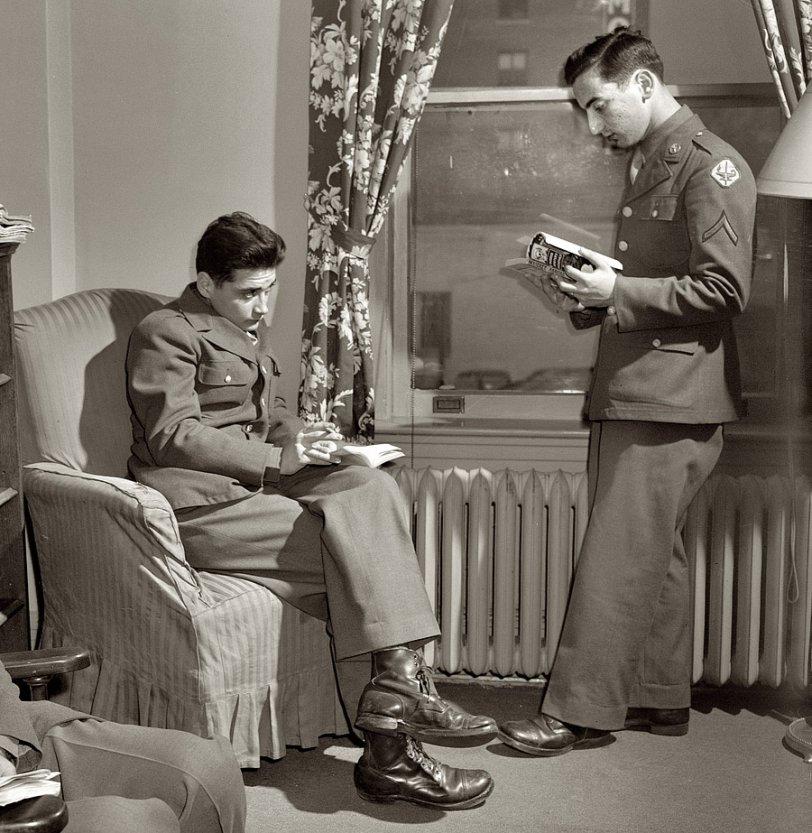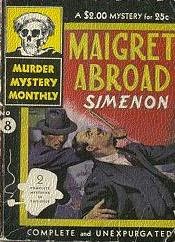


Framed or unframed, desk size to sofa size, printed by us in Arizona and Alabama since 2007. Explore now.
Shorpy is funded by you. Patreon contributors get an ad-free experience.
Learn more.

- Baldwin 62303
- Baldwin VO-1000
- Cold
- No expense spared
- Tough Guys
- Lost in Toyland
- And without gloves
- If I were a blindfolded time traveler
- Smoke Consumer Also Cooks
- Oh that stove!
- Possibly still there?
- What?!?
- $100 Reward
- Freeze Frame
- Texas Flyer wanted
- Just a Year Too Soon
- WWII -- Replacing men with women at the railroad crossing.
- Yes, Icing
- You kids drive me nuts!
- NOT An Easy Job
- I wonder
- Just add window boxes
- Icing Platform?
- Indiana Harbor Belt abides
- Freezing haze
- Corrections (for those who care)
- C&NW at Nelson
- Fallen Flags
- A dangerous job made worse
- Water Stop
Print Emporium
At Ease: 1943

December 1943. Another classic from Esther Bubley and her ever-inquiring camera: "Washington, D.C. In the library at the United Nations service center. Boys are urged to take books back to camp with them." View full size.
Maigret Abroad
Of course Lefty's expression is priceless, look at the book cover he's scoping...

Review from the 9/9/40 issue of TIME...
"MAIGRET ABROAD—Georges Simenon—Harcourt, Brace ($2). In Holland, the imperturbable Inspector Maigret deals with a crime of passion: the popping off of philandering Popinga. Maigret makes his pick and hands the case to Detective Pijpekamp for the kill. Proceeding then to Belgium, Maigret solves a murder at the Gai-Moulin in Liege. Principal actors are Adele, a danseuse, and two ne'er-do-well youths, always broke."
"Boys are urged to take books back to camp"
"And if there's some soldier reading the one you want, take him back to camp instead"! Very funny picture. Lefty's expression is priceless.
[I was beginning to think no one would notice. - Dave]
ASTP personal account
From "Old In Youth: Letters Home From A Young Infantryman During World War II," a memoir by Charles R. Remsburg, featured at the Library of Congress' Veterans History Project web site:
"On 26 Jan (1944) orders were finally issued. About a hundred and fifty of us were ordered to proceed by rail to the University of Dayton in southwestern Ohio. Here we would study engineering for an indefinite period of time. We wore on our left arm the blue and yellow A.S.T.P. identification patch, featuring the lamp of learning. Secretly we were slightly ashamed of this patch. It marked us as something less than soldiers. We couldn't hide the truth. We were college boys in uniform." (continue reading)
Mike_G
ASTP
The Army Specialized Training Program ("ASTP") was established by the United States Army in December 1942 to identify, train and educate academically-talented enlisted men as a specialized corp of Army officers during World War II. Utilizing major colleges and universities across the country, the Army provided a four-year college education combined with specialized Army technical training over a period of one and one-half years to those enlisted men who were accepted into the program. The men of the ASTP were distinguished by the octagon shoulder patch insignia of the program which was worn on their uniforms. It depicts the lamp of knowledge crossed with the sword of valor -- an allusion to both the mental and physical capabilities of these specialized officers-in-training.
ASTP soldiers were to serve as Army officers in both the successful prosecution of the war and the restoration of civilian governments in Nazi-occupied Europe after the war's end. But due to the impending invasion of Normandy and the need for additional manpower in its ground forces in Europe, the Army disbanded the program in early 1944. Most of the ASTP soldiers were then assigned to the infantry, where they fought in the European and Pacific Theaters of Operation.
I had occasion this week to research this program for a friend whose father was in the ASTP. He was posted as a medical officer in postwar Occupied Japan. Eventually he became a physician back home. The kind that still made house calls.
Shoulder Patch
The lamp insignia shoulder patch was for the National Defense Cadet Corps, a similar but less well-funded alternative to Junior ROTC (see http://www.geocities.com/raiderbattalion/Page6.3.htm for a small bit of history on the NDCC).
Shoulder Sleeve Insignia
The shoulder sleeve insignia for the soldier standing is yellow and blue and indicates he was a member of a Specialized Training Program in 1943. I don't know what kind of program that might have been.
[And in case anyone is interested, the book he's reading is "Maigret Abroad." - Dave]
























On Shorpy:
Today’s Top 5